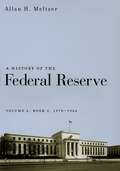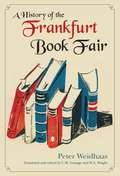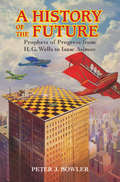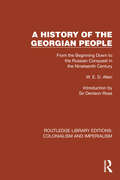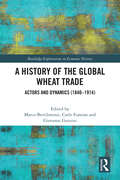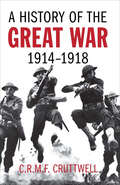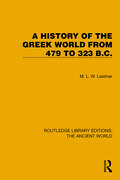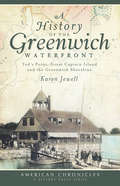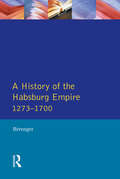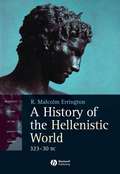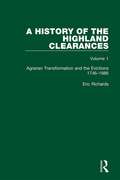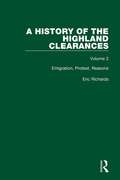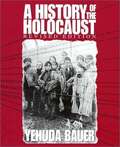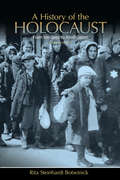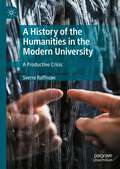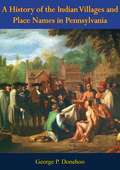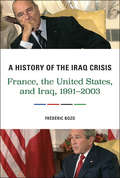- Table View
- List View
A History of the Federal Reserve: 1913–1951
by Allan H. MeltzerAllan H. Meltzer's monumental history of the Federal Reserve System tells the story of one of America's most influential but least understood public institutions. This first volume covers the period from the Federal Reserve's founding in 1913 through the Treasury-Federal Reserve Accord of 1951, which marked the beginning of a larger and greatly changed institution. To understand why the Federal Reserve acted as it did at key points in its history, Meltzer draws on meeting minutes, correspondence, and other internal documents (many made public only during the 1970s) to trace the reasoning behind its policy decisions. He explains, for instance, why the Federal Reserve remained passive throughout most of the economic decline that led to the Great Depression, and how the Board's actions helped to produce the deep recession of 1937 and 1938. He also highlights the impact on the institution of individuals such as Benjamin Strong, governor of the Federal Reserve Bank of New York in the 1920s, who played a key role in the adoption of a more active monetary policy by the Federal Reserve. Meltzer also examines the influence the Federal Reserve has had on international affairs, from attempts to build a new international financial system in the 1920s to the Bretton Woods Agreement of 1944 that established the International Monetary Fund and the World Bank, and the failure of the London Economic Conference of 1933. Written by one of the world's leading economists, this magisterial biography of the Federal Reserve and the people who helped shape it will interest economists, central bankers, historians, political scientists, policymakers, and anyone seeking a deep understanding of the institution that controls America's purse strings. "It was 'an unprecedented orgy of extravagance, a mania for speculation, overextended business in nearly all lines and in every section of the country.' An Alan Greenspan rumination about the irrational exuberance of the late 1990s? Try the 1920 annual report of the board of governors of the Federal Reserve. . . . To understand why the Fed acted as it did—at these critical moments and many others—would require years of study, poring over letters, the minutes of meetings and internal Fed documents. Such a task would naturally deter most scholars of economic history but not, thank goodness, Allan Meltzer."—Wall Street Journal "A seminal work that anyone interested in the inner workings of the U. S. central bank should read. A work that scholars will mine for years to come."—John M. Berry, Washington Post "An exceptionally clear story about why, as the ideas that actually informed policy evolved, things sometimes went well and sometimes went badly. . . . One can only hope that we do not have to wait too long for the second installment."—David Laidler, Journal of Economic Literature "A thorough narrative history of a high order. Meltzer's analysis is persuasive and acute. His work will stand for a generation as the benchmark history of the world's most powerful economic institution. It is an impressive, even awe-inspiring achievement."—Sir Howard Davies, Times Higher Education Supplement
A History of the Federal Reserve: Book 1, 1951–1969
by Allan H. MeltzerAllan H. Meltzer’s critically acclaimed history of the Federal Reserve is the most ambitious, most intensive, and most revealing investigation of the subject ever conducted. Its first volume, published to widespread critical acclaim in 2003, spanned the period from the institution’s founding in 1913 to the restoration of its independence in 1951. This two-part second volume of the history chronicles the evolution and development of this institution from the Treasury–Federal Reserve accord in 1951 to the mid-1980s, when the great inflation ended. It reveals the inner workings of the Fed during a period of rapid and extensive change. An epilogue discusses the role of the Fed in resolving our current economic crisis and the needed reforms of the financial system.In rich detail, drawing on the Federal Reserve’s own documents, Meltzer traces the relation between its decisions and economic and monetary theory, its experience as an institution independent of politics, and its role in tempering inflation. He explains, for example, how the Federal Reserve’s independence was often compromised by the active policy-making roles of Congress, the Treasury Department, different presidents, and even White House staff, who often pressured the bank to take a short-term view of its responsibilities. With an eye on the present, Meltzer also offers solutions for improving the Federal Reserve, arguing that as a regulator of financial firms and lender of last resort, it should focus more attention on incentives for reform, medium-term consequences, and rule-like behavior for mitigating financial crises. Less attention should be paid, he contends, to command and control of the markets and the noise of quarterly data.At a time when the United States finds itself in an unprecedented financial crisis, Meltzer’s fascinating history will be the source of record for scholars and policy makers navigating an uncertain economic future.
A History of the Federal Reserve: Book 2, 1970–1986
by Allan H. MeltzerAllan H. Meltzer’s critically acclaimed history of the Federal Reserve is the most ambitious, most intensive, and most revealing investigation of the subject ever conducted. Its first volume, published to widespread critical acclaim in 2003, spanned the period from the institution’s founding in 1913 to the restoration of its independence in 1951. This two-part second volume of the history chronicles the evolution and development of this institution from the Treasury–Federal Reserve accord in 1951 to the mid-1980s, when the great inflation ended. It reveals the inner workings of the Fed during a period of rapid and extensive change. An epilogue discusses the role of the Fed in resolving our current economic crisis and the needed reforms of the financial system.In rich detail, drawing on the Federal Reserve’s own documents, Meltzer traces the relation between its decisions and economic and monetary theory, its experience as an institution independent of politics, and its role in tempering inflation. He explains, for example, how the Federal Reserve’s independence was often compromised by the active policy-making roles of Congress, the Treasury Department, different presidents, and even White House staff, who often pressured the bank to take a short-term view of its responsibilities. With an eye on the present, Meltzer also offers solutions for improving the Federal Reserve, arguing that as a regulator of financial firms and lender of last resort, it should focus more attention on incentives for reform, medium-term consequences, and rule-like behavior for mitigating financial crises. Less attention should be paid, he contends, to command and control of the markets and the noise of quarterly data.At a time when the United States finds itself in an unprecedented financial crisis, Meltzer’s fascinating history will be the source of record for scholars and policy makers navigating an uncertain economic future.
A History of the Frankfurt Book Fair
by Carolyn Gossage Peter Weidhaas Wendy A. WrightA colourful and revealing look at more than 500 years of commerce conducted at the renowned Frankfurt Book Fair, from its beginnings in the Middle Ages. Even then, in spite of internal strife and religious upheaval, books were becoming increasingly accessible to those who found their way to Frankfurt to buy, sell, and promote. The fact that King Henry VIII sent Sir Thomas Bodley as his personal emissary to purchase books for the new library at Oxford University is an indication of the Fair’s growing importance outside Germany. Through the ensuing centuries, the fortunes of the Fair waxed and waned; however, the period following the Second World War brought with it a new spirit of renewal that has yet to lose momentum. In recent years, increasing number of international book fairs have taken the Frankfurt model, and each is finding its own way to further enrich the world of books everywhere.
A History of the Future: Prophets of Progress from H. G. Wells to Isaac Asimov
by Peter J. BowlerIn this wide-ranging survey, Peter J. Bowler explores the phenomenon of futurology: predictions about the future development and impact of science and technology on society and culture in the twentieth century. Utilising science fiction, popular science literature and the novels of the literary elite, Bowler highlights contested responses to the potential for revolutionary social change brought about by real and imagined scientific innovations. Charting the effect of social and military developments on attitudes towards innovation in Europe and America, Bowler shows how conflict between the enthusiasm of technocrats and the pessimism of their critics was presented to the public in books, magazines and exhibitions, and on the radio and television. A series of case studies reveals the impact of technologies such as radio, aviation, space exploration and genetics, exploring rivalries between innovators and the often unexpected outcome of their efforts to produce mechanisms and machines that could change the world.
A History of the Georgian People: From the Beginning Down to the Russian Conquest in the Nineteenth Century (Routledge Library Editions: Colonialism and Imperialism #2)
by W.E.D. AllenA History of the Georgian People (1971) begins with an account of the early history and ethnographic background of Georgia, and goes on to cover the country’s political history from 1000 to 1800 and Russian conquest. There are chapters on the social history of the country, with much interesting information on the feudal system, religion, justice and the slave trade. The final, illustrated section, discusses the art and literature of the Georgians.
A History of the Global Economy
by Joerg BatenWhy are some parts of the world poor today, while others are rich? At which point in time did they diverge, and what were the reasons? These core questions are addressed in a concise and accessible introduction to global economic development since 1500. Leading economic historians from across the globe provide overviews of major world regions together with global comparison chapters and case studies highlighting key themes, individuals, processes and events. Utilising a set of common developmental indicators, the chapters address crucial issues such as how international trade and migration, institutions and flows of physical and human capital impacted economic growth. Richly illustrated with informative figures, maps, tables and charts, A History of the Global Economy summarises the key economic findings, debates and ideas, and provides students and the interested public with an up-to-date and engaging introduction to the origins and evolution of today's global economy.
A History of the Global Wheat Trade: Actors and Dynamics (1840-1914) (Routledge Explorations in Economic History)
by Marco Bertilorenzi Carlo Fumian Giovanni GozziniDuring the second half of the 19th century, a new global market for wheat came to the fore. Ever since, scarce and perishable food has been transformed into a modern global commodity, millions of tons of which is sold, bought, and transported across the oceans, providing the “daily bread” for a fast-growing world population.This book explores the historical origin of the global wheat market, offering an actor-centred view of the history of this new global commodity. The contributions to this volume demonstrate that the development of the global wheat trade through the late 19th and early 20th centuries has not only impacted the world food regime, it also led to the dissemination of new economic institutions. Countless technological innovations, such as elevators or telegraphic lines, have paved the way to the creation of new financial tools for trade, such as futures and grain exchanges, which transformed the market. The book also examines new global actors, such as Cargill, Louis-Dreyfus, or Bunge y Born, who took advantage of the new opportunities provided by the interlinked and globalized world grain trade. For the first time in history, the price of a single commodity which was crucial for human life ended up being decided in the areas of production by the producers and started to be fixed further afield, in specific and anonymous trading places.The book will be of great interest to historians of economics, business, trade, agriculture, globalization, and commodities.
A History of the Grandparents I Never Had
by Ivan JablonkaIvan Jablonka's grandparents' lives ended long before his began: although Matès and Idesa Jablonka were his family, they were perfect strangers. When he set out to uncover their story, Jablonka had little to work with. Neither of them was the least bit famous, and they left little behind except their two orphaned children, a handful of letters, and a passport. Persecuted as communists in Poland, as refugees in France, and then as Jews under the Vichy regime, Matès and Idesa lived their short lives underground. They were overcome by the tragedies of the twentieth century: Stalinism, the mounting dangers in Europe during the 1930s, the Second World War, and the destruction of European Jews. Jablonka's challenge was, as a historian, to rigorously distance himself and yet, as family, to invest himself completely in their story. Imagined oppositions collapsed--between scholarly research and personal commitment, between established facts and the passion of the one recording them, between history and the art of storytelling. To write this book, Jablonka traveled to three continents; met the handful of survivors of his grandparents' era, their descendants, and some of his far-flung cousins; and investigated twenty different archives. And in the process, he reflected on his own family and his responsibilities to his father, the orphaned son, and to his own children and the family wounds they all inherited. A History of the Grandparents I Never Had cannot bring Matès and Idesa to life, but Jablonka succeeds in bringing them, as he soberly puts it, to light. The result is a gripping story, a profound reflection, and an absolutely extraordinary history.
A History of the Great War, 1914–1918: 1914-1918
by C.R.M.F. CruttwellThis vivid, detailed history of World War I presents the general reader with an accurate and readable account of the campaigns and battles, along with brilliant portraits of the leaders and generals of all countries involved. Scrupulously fair, praising and blaming friend and enemy as circumstances demand, this has become established as the classic account of the first world-wide war.
A History of the Greek World from 323 to 146 B.C. (Routledge Library Editions: The Ancient World)
by M. CaryA History of the Greek World from 323 to 146 B.C. (1951) looks at the period of Greek history from the Macedonian to the Roman conquests. It contains a narrative of the political history of the Hellenistic states; a description of their statecraft, war-craft and economic practice; and a summary of later Greek achievement in the fields of art, literature, science, philosophy and religion.
A History of the Greek World from 479 to 323 B.C. (Routledge Library Editions: The Ancient World)
by M.L.W. LaistnerA History of the Greek World from 479 to 323 B.C. (1957) examines the period of Greek history – from the end of the Persian Wars to the death of Alexander the Great – which can claim to be unique in the history of the world. Into the brief space of five generations are crowded such a galaxy of great poets, artists, politicians and thinkers, whose creative achievements directly or indirectly exerted an unparalleled influence on Western civilisation since.
A History of the Greek and Roman World (Routledge Library Editions: The Ancient World)
by G.B. GrundyA History of the Greek and Roman World (1926) is a single-volume sweeping examination of the Greek and Roman civilisations from 2000 B.C. to the second century A.D. It covers all parts of the Greek and Roman worlds, and all aspects of their societies over the different time periods: culture, politics and religion.
A History of the Greek and Roman World (Routledge Revivals)
by George B. GrundyA History of the Greek and Roman World, first published in 1926, presents the story of Graeco-Roman antiquity from its earliest recorded origins to the height of the Roman imperium. It aims to bring into prominence the internal dynamism - political, cultural, intellectual, and aesthetic – which animated the ancient peoples at different periods of their history, and to draw attention to the physical, socio-economic and religious conditions under which they lived. Written in a style which will likely be unfamiliar to modern readers, Grundy’s historical portrait is painted with broad brush-strokes, offering not only compelling narrative but also incisive commentary on the individuals and societies which occupy the foreground. A History of the Greek and Roman World will be of interest for the general enthusiast as well as students, who may value such a radically different approach to the interpretation of antiquity compared to the conventions which prevail amongst contemporary scholars.
A History of the Greenwich Waterfront: Tod's Point, Great Captain Island and the Greenwich Shoreline (American Chronicles Ser.)
by Karen JewellThe historic community of Greenwich is nestled along Connecticut's famed Gold Coast. The shores and waves of Long Island Sound draw people to its unique seaside, which also maintains a peaceful "residents only" beach. As a coastal community the opportunities for businesses were plentiful, from the exporting of oysters to the Palmer Engine Company who supplied engines for every lifeboat during WWII. This pristine waterfront is home to historic Tod's Point and has a plethora of elite Yacht Clubs dotting the shoreline. Author Karen Jewell chronicles the lives of distinguished citizens and the memories of yesteryear in her latest coastal narrative detailing the Greenwich waterfront.
A History of the Habsburg Empire 1273-1700
by Jean Berenger C.A. SimpsonThe first part of a two-volume history of the Habsburg Empire from its medieval origins to its dismemberment in the First World War.This important volume (which is self-contained) meets a long-felt need for a systematic survey in English of the Habsburgs and their lands in the late medieval and early modern periods. It is primarily concerned with the Habsburg territories in central and northern Europe, but the history of the Spanish Habsburgs in Spain and the Netherlands is also covered. The book, like the Habsburgs themselves, deals with an immense range of lands and peoples: clear, balanced, and authoritative, it is a remarkable feat of synthethis and exposition.
A History of the Hellenistic World: 323 - 30 BC (Blackwell History of the Ancient World #13)
by R. Malcolm ErringtonA History of the Hellenistic World provides an engaging look at the Macedonian monarchies in the period following the reign of Alexander the Great, and examines their impact on the Greek world. Offers a clearly organized narrative with particular emphasis on state and governmental structures Makes extensive use of inscriptions in translation to illustrate the continuing vitality of the Greek city states prior to the Roman conquest Emphasizes the specific Macedonian origins of all active participants in the creation of the Hellenistic world Highlights the relationships between Greek city-states and Macedonian monarchies
A History of the Highland Clearances: Agrarian Transformation and the Evictions 1746-1886
by Eric RichardsFirst published in 1982, A History of the Highland Clearances looks at the forcible clearance of tenants from land they had farmed for centuries by landlords in the Highlands of Scotland in the early nineteenth century. It examines the general context of historical change, provides a full narrative of the clearances and offers a critical evaluation of the documentary sources upon which the entire story depends. By placing his subject in its historical perspective and into the context of the rest of Britain and Europe, Eric Richards vividly illustrates the realities of the Highland experience in the age of the clearances.
A History of the Highland Clearances: Emigration, Protest, Reasons
by Eric RichardsFirst published in 1985, A History of the Highland Clearances: Volume 2 explores the various types of communal and intellectual responses, contemporary and retrospective, to the experience of the clearances. The first section considers the legacy of the two hundred years’ debate about the Highland problem and the place of the clearances therein. The second section assesses the scale, range and timing of the emigrations of the Highlanders, as well as some of the motivations. The third section contemplates the direct popular response to the clearances, the collective memory and the tradition of physical resistance. The fourth section is about the career, trial and reputation of Patrick Sellar, which together embodied much of the social history, ruling ideas, and the necessary mythology of the clearances. The final section considers the fundamental economic problem of the Highlands in the age of the clearances, and the moral and economic alternatives that faced the community, the landlords, and the nation.
A History of the Holocaust (Revised Edition)
by Yehuda Bauer Nili KerenThe author traces the roots of anti-Semitism that burgeoned through the ages and provides a comprehensive description of how and why the Holocaust occurred.
A History of the Holocaust: From Ideology to Annihilation
by Rita Steinhardt BotwinickTold with scrupulous attention to detail and accuracy, this text provides important background information on Jewish life in Europe, the functions of the hierarchy within the Nazi government, and the psychological foundations of prejudice. Unlike other texts on the subject, A History of the Holocaust gives students an idea of just who the victims of the Holocaust were. In fact, the author tells this story from a unique point-of-view, having experienced Nazi Germany as a child.
A History of the Humanities in the Modern University: A Productive Crisis
by Sverre RaffnsøeThis book challenges commonplace assertions that the humanities are presently undergoing a severe crisis as a result of a longstanding decline. Rather than hearkening to the widespread, reactive call for a last-ditch defense of the humanities under attack from an ungracious world, this book fundamentally reverses the perspective and makes a plea for a different, affirmative approach. It contends that the humanities have incessantly arrived at critical turning points since they were first constituted in a form that remains recognizable today and assumed a leading role in knowledge organization with the establishment of the modern university around 1800. Assuming a historical perspective, the monograph takes the human sciences back to their rightful place in the family tree of sciences and gives due recognition to their continuously decisive role in the production of new knowledge and the creation of new fields of knowledge. Situating the ongoing gemmation of the humanities in a broader context, this monograph also offers an encompassing introduction to the over-all development of knowledge in the last two hundred years.
A History of the Indian Villages and Place Names in Pennsylvania
by George P. DonehooNo state in the entire Nation is richer in Indian names, or in fact, in Indian history than Pennsylvania. These Indian names of Pennsylvania are full of music, but, of far greater importance, they are full of history. A History of the Indian Villages and Place Names in Pennsylvania, which was first published in 1928, is the only major book of the 20th century that traces Pennsylvania’s Indian place and names for their correct form, origin and history. Its pages are filled with the most incredible collection of information ever assembled on the Indian villages of Pennsylvania and their Indian place names and is an Indian history scholar’s delight.In preparing his book, Dr. Donehoo researched every available source of printed material about Indian place names in Pennsylvania. He also walked nearly every Indian trail, from the Delaware to the Ohio, using early trader’s journals and maps as his guide, to seek out the places the Indians lived. Each Indian name comes complete with historical notes by the author. The book includes a list of all the sources used to authenticate each Indian place name. An excellent bibliography follows at the conclusion of the work along with appendixes listing: the Indian villages of New York destroyed by General Sullivan’s army in 1779, prehistoric works in Pennsylvania by county, and an alphabetical listing of all Indian named places in each county.
A History of the Iraq Crisis: France, the United States, and Iraq, 1991-2003
by Frédéric BozoIn March 2003, the United States and Great Britain invaded Iraq to put an end to the regime of Saddam Hussein. The war was launched without a United Nations mandate and was based on the erroneous claim that Iraq had retained weapons of mass destruction. France, under President Jacques Chirac and Foreign Minister Dominique de Villepin, spectacularly opposed the United States and British invasion, leading a global coalition against the war that also included Germany and Russia. The diplomatic crisis leading up to the war shook both French and American perceptions of each other and revealed cracks in the transatlantic relationship that had been building since the end of the Cold War.Based on exclusive French archival sources and numerous interviews with former officials in both France and the United States, A History of the Iraq Crisis retraces the international exchange that culminated in the 2003 Iraq conflict. It shows how and why the Iraq crisis led to a confrontation between two longtime allies unprecedented since the time of Charles de Gaulle, and it exposes the deep and ongoing divisions within Europe, the Atlantic alliance, and the international community as a whole. The Franco-American narrative offers a unique prism through which the American road to war can be better understood.
A History of the Iraq Crisis: France, the United States, and Iraq, 1991–2003
by Frédéric BozoIn March 2003, the United States and Great Britain invaded Iraq to put an end to the regime of Saddam Hussein. The war was launched without a United Nations mandate and was based on the erroneous claim that Iraq had retained weapons of mass destruction. France, under President Jacques Chirac and Foreign Minister Dominique de Villepin, spectacularly opposed the United States and British invasion, leading a global coalition against the war that also included Germany and Russia. The diplomatic crisis leading up to the war shook both French and American perceptions of each other and revealed cracks in the transatlantic relationship that had been building since the end of the Cold War.Based on exclusive French archival sources and numerous interviews with former officials in both France and the United States, A History of the Iraq Crisis retraces the international exchange that culminated in the 2003 Iraq conflict. It shows how and why the Iraq crisis led to a confrontation between two longtime allies unprecedented since the time of Charles de Gaulle, and it exposes the deep and ongoing divisions within Europe, the Atlantic alliance, and the international community as a whole. The Franco-American narrative offers a unique prism through which the American road to war can be better understood.


